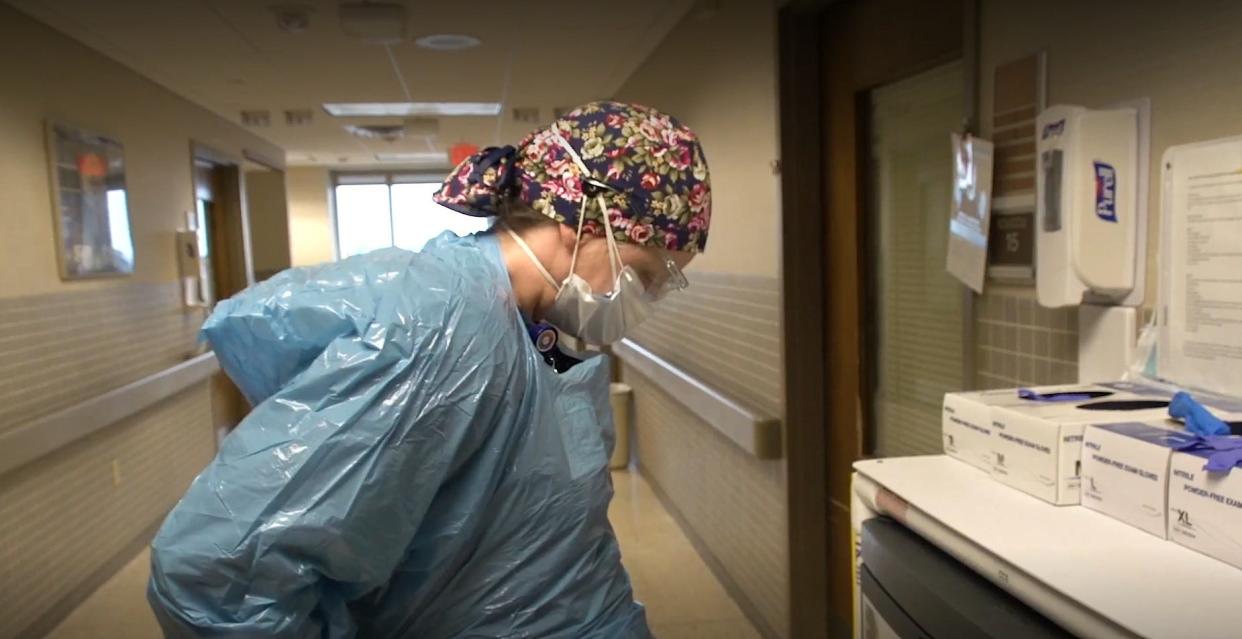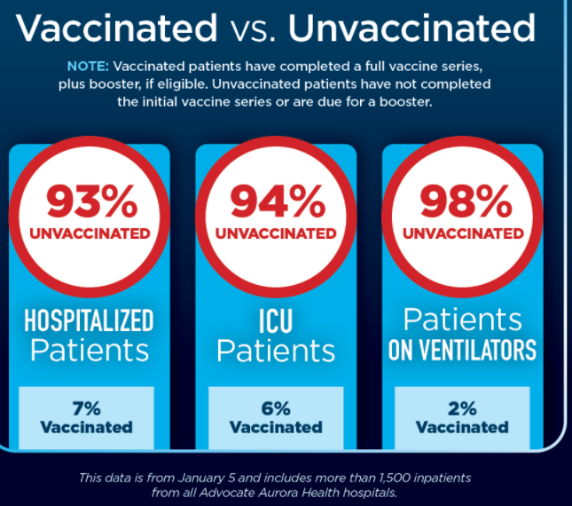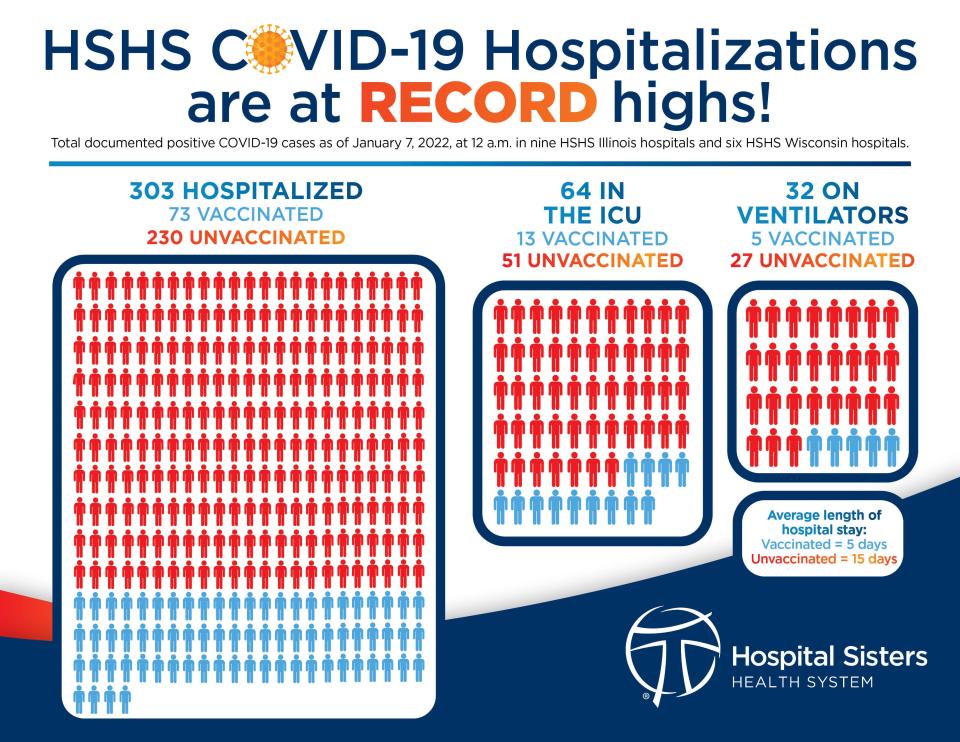Omicron sweeps through Sheboygan County: One in 100 people tested positive in one week, hospitals at near capacity

SHEBOYGAN - COVID-19 case rates and hospitalizations are hitting record highs in Sheboygan County.
Monthly COVID-19 cases in the county have been increasing since June, with the spread of the Delta variant, and surged heading into winter. Then, Omicron hit.
In a presentation Tuesday, Sheboygan County public health officials said the number of active cases had increased more than 250% in the last week.
On Wednesday, the seven-day case rate for the county surpassed one in 100 people infected with COVID-19 (1,610 per 100,000), according to the Sheboygan County COVID-19 dashboard.
Late last month, the number of people in Wisconsin who have had confirmed cases of COVID-19 surpassed 1 million, according to state data.
By the numbers: Cases, hospitalizations and vaccination rates in Sheboygan County
Unless otherwise noted, the following data are from the Wisconsin Department of Health Services, as of Jan. 10.
Cases:
There have been 23,500 confirmed cases of COVID-19 in Sheboygan County since the beginning of the pandemic (which is likely less than the total number); and
There have been an average of 216 new confirmed cases of COVID-19 per day in the county so far in January (compared with 71 new confirmed cases per day in December).
Hospitalizations and deaths:
34 people have been hospitalized with confirmed or probable cases of COVID-19 in January and 98 people were in December. These numbers do not include people transferred to hospitals in other counties.
Five people have died from COVID-19 in January. Six people died from COVID-19 in December.
Vaccination rates:
61% of people in the county have received at least one dose of the vaccine, up from about 57% in late November.
Nearly half (47%) of people in the county who are fully vaccinated and eligible for a booster shot have received one, according to public health officials.
According to statewide November data, people not fully vaccinated were five times more likely to be diagnosed with COVID-19, 11 times more likely to be hospitalized with COVID-19 and 12 times more likely to die from COVID-19 than people who were fully vaccinated
Hospitals running at near-capacity
An influx of COVID-19 patients — combined with burnout of health care workers and staffing shortages — has stressed local hospitals.
Both HSHS Hospitals and Advocate Aurora Health recently reported having the highest number of COVID-19 patients in their hospitals since the beginning of the pandemic.
The number of COVID-19 patients is putting a big strain on the network’s hospitals, said Dr. Robert Citronberg, executive medical director of infectious disease and prevention at Advocate Aurora Health.
As of Jan. 12, Advocate Aurora Health COVID-19 inpatients had increased 11.5% from the previous week and 116% from December.

“To say we are concerned and disheartened cannot begin to explain our frustration,” said Dr. Marc Shelton, SVP and chief clinical officer for HSHS Hospitals, in a news release last week. “HSHS was hopeful to have turned a corner when the vaccine became readily available, but we are now well over a year into vaccine availability and yet our hospitals have reached a new record number of COVID-19 hospitalizations primarily due to unvaccinated patients.”
HSHS hospitals are stressed and “at near-capacity almost daily,” said HSHS Wisconsin Chief Nursing Executive Ken Nelson.

As of Jan. 11, according to data from the state DHS, in Wisconsin’s Southeast region (which Sheboygan County belongs to):
95% of hospital beds are in use and 96% of Intensive Care Unit beds are occupied; and
56% of hospitals are at overall peak capacity, with 71% of hospitals reporting their ICUs at peak capacity
Cases in schools increase, compound existing staff shortages
In schools’ first week back from winter break, the average number of daily active COVID-19 cases among students and staff in the Sheboygan Area School District more than doubled compared to that average for the month of December.
With 255 active student cases and 818 students in quarantine, more than one in 10 students in the district were absent from school as a result of COVID-19 on Monday.
Four schools reached more than 10% of staff positive on Monday, with 62 active staff cases of COVID-19 across the district, according to the SASD COVID-19 dashboard.
SASD Superintendent Seth Harvatine said that increased COVID-19 cases over the school year have compounded existing staff shortages in the district.
More: Four people hospitalized after multi-vehicle crash in Sheboygan County
More: Throwback Thursday: Sheboygan mineral water plant part of city's rich water history
'What we know … is that we need everyone and every sector to do their part': Here's what you can do
Local public health officials emphasize that getting vaccinated and getting a booster shot are important strategies to help limit the spread of COVID-19 in Sheboygan County.
Adults and children age 5 and older should get a COVID-19 vaccine. In addition, everyone age 12 and older is now eligible for a booster shot, as long as they are six months out from completing the Pfizer or Moderna vaccine series or two months out from receiving a dose of the Johnson & Johnson vaccine.
Other strategies to limit spread include:
Wearing a mask. At this time, everyone 2 years of age or older who is not fully vaccinated should wear a mask indoors in public. To maximize protection from the Omicron variant, fully vaccinated people should also wear a mask indoors in public.
Choosing outdoor spaces. Gathering outdoors is safer than indoors. In general, you do not need to wear a mask in outdoor settings. Consider wearing a mask in crowded outdoor settings and for activities with close contact with others who are not fully vaccinated.
Staying home if you are sick.
With the recent influx in cases, the health department is experiencing delays in contact tracing, according to Zachary Metrou, a health educator with the department.
“To help assist our team, we encourage individuals to fill out our online COVID Positive Case Interview in lieu of a phone call,” he said. The form is available in English, Spanish and Hmong.
Metrou added, “What we know about the spread is that we need everyone and every sector to do their part to help limit it."
Reach Maya Hilty at 920-400-7485 or MHilty@sheboygan.gannett.com. Follow her on Twitter at @maya_hilty.
This article originally appeared on Sheboygan Press: Sheboygan County: Omicron cases surge; hospitals at near capacity

